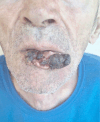Influence of the patient's demographic profile and tumor characteristics on reconstructive techniques in lip cancers
- PMID: 40384208
- PMCID: PMC12236273
- DOI: 10.47162/RJME.66.1.21
Influence of the patient's demographic profile and tumor characteristics on reconstructive techniques in lip cancers
Abstract
With an incidence of approximately 30% of all oral cavity neoplasms, lip cancer significantly impacts the patient quality of life (QoL). The frequent localization is in the lower lip, predominantly affecting men aged between 60-70 years old. The surgical treatment aims at aesthetic and functional reconstruction of the lip. The present study aims at defining a demographic profile of patients with lip cancer and at establishing correlations between tumor characteristics and reconstruction methods. The analysis of the group of 26 patients showed that the lip cancer patient was predominantly female, urban, with a mean age of 73.27±11.17 years old, with squamous cell carcinoma of the lower lip, mean diameter of 1.52 cm and mean depth of 0.72 cm. The tumor characteristics revealed a guide of the decision on the method of lip reconstruction, considering the correlations between a variety of factors, including the size of the affected area, etiology and location of the formation, integration of the flap into the relaxed skin tension lines, the patient general condition, and the degree of cooperation. Regardless of the reconstructive method chosen, the aim is to preserve the functions of the lip in mastication, speech and definition of facial expression. Complex cases require extensive reconstructive interventions involving combinations of various types of flaps. Multidisciplinary management of these patients leads to improved QoL and prevention of recurrences.
Keywords: lip carcinoma; lip pathology; quality of life; reconstructive methods; risk factors.
Conflict of interest statement
The authors declare that they have no conflict of interests.
Figures




























Similar articles
-
Composite Reconstruction With Irradiated Autograft Plus Total Hip Replacement After Type II Pelvic Resections for Tumors Is Feasible but Fraught With Complications.Clin Orthop Relat Res. 2024 Oct 1;482(10):1825-1835. doi: 10.1097/CORR.0000000000003097. Epub 2024 Apr 26. Clin Orthop Relat Res. 2024. PMID: 38666740
-
Systemic pharmacological treatments for chronic plaque psoriasis: a network meta-analysis.Cochrane Database Syst Rev. 2017 Dec 22;12(12):CD011535. doi: 10.1002/14651858.CD011535.pub2. Cochrane Database Syst Rev. 2017. Update in: Cochrane Database Syst Rev. 2020 Jan 9;1:CD011535. doi: 10.1002/14651858.CD011535.pub3. PMID: 29271481 Free PMC article. Updated.
-
Systemic pharmacological treatments for chronic plaque psoriasis: a network meta-analysis.Cochrane Database Syst Rev. 2021 Apr 19;4(4):CD011535. doi: 10.1002/14651858.CD011535.pub4. Cochrane Database Syst Rev. 2021. Update in: Cochrane Database Syst Rev. 2022 May 23;5:CD011535. doi: 10.1002/14651858.CD011535.pub5. PMID: 33871055 Free PMC article. Updated.
-
Comparison of Two Modern Survival Prediction Tools, SORG-MLA and METSSS, in Patients With Symptomatic Long-bone Metastases Who Underwent Local Treatment With Surgery Followed by Radiotherapy and With Radiotherapy Alone.Clin Orthop Relat Res. 2024 Dec 1;482(12):2193-2208. doi: 10.1097/CORR.0000000000003185. Epub 2024 Jul 23. Clin Orthop Relat Res. 2024. PMID: 39051924
-
Complications Following Local-Flap Lip Reconstruction After Tumor Removal: A Systematic Review.Cureus. 2025 May 31;17(5):e85155. doi: 10.7759/cureus.85155. eCollection 2025 May. Cureus. 2025. PMID: 40599512 Free PMC article. Review.
References
-
- Czerninski R, Zini A, Sgan-Cohen HD. Lip cancer: incidence, trends, histology and survival: 1970-2006. Br J Dermatol. 2010;162(5):1103–1109. - PubMed
-
- Alhabbab R, Johar R. Lip cancer prevalence, epidemiology, diagnosis, and management: a review of the literature. Adv Oral Maxillofacial Surg. 2022;6:100276–100276.
-
- Chen L, Wang Z, Zhang S, Gong Z, Wang K, Wu H. A novel method for reconstruction of the lower lip after lip cancer ablation: double Abbe flap. J Oral Maxillofac Surg. 2020;78(3):488–488. - PubMed
-
- Biasoli ÉR, Valente VB, Mantovan B, Collado FU, Neto SC, Sundefeld ML, Miyahara GI, Bernabé DG. Lip cancer: a clinicopathological study and treatment outcomes in a 25-year experience. J Oral Maxillofac Surg. 2016;74(7):1360–1367. - PubMed
MeSH terms
LinkOut - more resources
Full Text Sources
Medical

